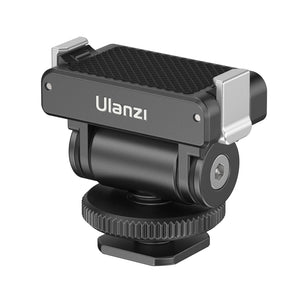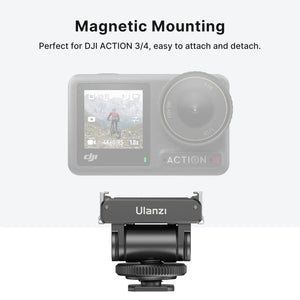Key Takeaways
Remember these five points if you remember nothing else. They are the most critical actions you can take to keep your camera safe and your footage secure.
- Immediately: Apply a tempered glass screen and lens protector.
- Always: Use the included protective cover or a gimbal lock for transport.
- Invest In: A quality case that fits your lifestyle and strongly consider DJI Care Refresh.
- Be Aware: Keep the device away from water, dust, and extreme temperatures.
- Secure Your Data: Use a high-speed microSD card and back up your footage religiously.
The DJI Osmo Pocket 3 puts incredible filmmaking power right in your palm. But its sophisticated gimbal, rotating screen, and compact body are also incredibly delicate. A single drop can easily lead to a scratched lens or a damaged motor. Protecting your new camera requires more than just being careful; it requires the right gear and handling techniques. Here are some of the best ways to shield your investment from physical damage, weather, and data loss.
Your Osmo Pocket 3's First Line of Defense: Physical Protection
Before worrying about filming techniques, you need to secure the camera's body, lens, and screen. Physical protection is the foundation of keeping your Pocket 3 in top condition for years.

Screen and Lens Protectors
A screen and lens protector kit should be the first accessory you buy. The Pocket 3's large, rotating touchscreen is your main control panel and is always exposed. The camera lens, while made of durable glass, is also vulnerable to damage. A single deep scratch on either can ruin your footage or make the camera frustrating to use. High-quality tempered glass offers the best protection.
- Look for a kit with a "Hardness" rating, which means it can resist scratches from sharp objects like keys in your pocket.
- Make sure the kit includes protectors for both the screen and the main camera lens. A good protector will also have high transparency so it won't negatively affect image quality.
- Many also have an oleophobic coating to resist fingerprints and smudges, keeping your view clear.
- Film protectors are cheaper but offer much less impact protection than tempered glass. This small investment can save you from a very expensive repair.
Choosing the Right Case for Your Osmo Pocket 3
The basic protective cover included with your camera is a start, but different situations call for different cases. The right one depends entirely on how you plan to shoot.
- The Included Protective Cover: This plastic shell is designed specifically to lock the gimbal in place, preventing it from swinging around during transport. It's perfect for tossing the camera into a dedicated pouch in a backpack. Its main weakness is that it provides almost no real protection against drops or impacts.
- Silicone Sleeves: For everyday vlogging or general use, a silicone sleeve is a great option. These soft, rubbery cases wrap around the Pocket 3's body. They add a significant amount of grip, making the slick camera much easier to hold. They also absorb the shock from minor bumps and prevent scuffs and scratches on the body. Best of all, they do this without adding much bulk.
- Hard Cases: If you are a traveler or frequently shoot in rough environments, a dedicated hard case is non-negotiable. These cases are built to withstand serious abuse. The best ones have a tough outer shell and custom-cut foam on the inside. The foam should have precise cutouts for the Pocket 3 (with its cover on), the battery handle, a microphone, and other accessories. This design stops everything from rattling around and provides the ultimate protection from drops, pressure, dust, and sometimes even water.
Safeguarding the Gimbal: The Heart of Your Camera
The 3-axis gimbal is what makes your footage so smooth, but its tiny motors and delicate parts make it the most fragile component. Protecting it comes down to two key rules.
- Always use the protective cover for transport. When the camera is off, the gimbal head can swing freely and get damaged. The included cover locks it down. If you lose yours, buy a replacement immediately—it's that important.
- Never force or block the gimbal's movement. When you turn the camera on or off, it performs a startup and shutdown sequence. Let it complete this process without interference. Pushing the gimbal with your hand or blocking its path can strain or burn out the motors, leading to jittery footage or a complete failure.
Preventing Accidental Drops with Lanyards and Wrist Straps
This is a simple but effective way to prevent disaster. The Pocket 3 has an attachment point for a lanyard or wrist strap. Using one can be the difference between a close call and a shattered camera. When you're vlogging while walking, shooting over a ledge, or in a crowd, keeping the camera tethered to your wrist provides real security.
Operational and Environmental Safety for Your DJI Osmo Pocket 3

How you use your Pocket 3 and the places you take it are just as important for its long-term health as any case or screen protector.
Guarding Against Water, Dust, and Heat
Your Pocket 3 is a sensitive electronic device that needs protection from the elements.
- Water: The DJI Osmo Pocket 3 is not waterproof or water-resistant. Rain, mist, or even high humidity can cause permanent damage. If you must film in damp conditions, stay under an umbrella and put the camera away immediately after. For any underwater or heavy rain shots, you need the DJI underwater housing, which is sold separately.
- Dust and Sand: Be careful at the beach or on dusty trails. Fine particles of sand can get into the gimbal mechanism or scratch the lens. In these areas, avoid changing lenses or removing the SD card. Afterward, use a small air blower to gently remove any grit from the gimbal and body before wiping it with a soft cloth.
- Temperature: High heat can damage electronics and batteries. Never leave your Pocket 3 in a hot car. In very cold weather, batteries drain much faster. To manage this, keep the camera in an inside pocket close to your body when not in use, and carry spare batteries.
DJI Care Refresh: An Insurance Option
Can DJI Care Refresh Be Transferred? (Solved!) · Drone Jungle is an insurance plan for your camera. You pay an upfront fee for a one or two-year plan. If you accidentally damage your camera during that time—from a drop, impact, or even water—you can get a replacement unit for a small service fee. To see if it's worth it, compare the plan and service fees to the cost of buying a new Pocket 3. For people who travel often or shoot in active situations, the peace of mind can be valuable.
Firmware Updates and Proper Handling
Keeping your camera's software updated is part of its maintenance. DJI regularly releases firmware updates through the Mimo app that fix bugs and improve performance. A stable camera is a reliable one, so always check for an update before an important shoot. Finally, remember to let the camera complete its full shutdown sequence before putting it away to protect the delicate gimbal motors.
Protecting Your Content: Osmo Pocket 3 Data Integrity and Security
Protecting the camera is only half the battle; you also need to protect the valuable footage you create with it. A few good habits can prevent the heartbreak of lost or corrupted files.
Choose the Right MicroSD Card
Micro-SD Card Low Power Showdown - Part II | Neurotech Hub | Washington University in St. Louis directly affects your recordings. A slow or unreliable card can cause errors, dropped frames, or corrupted files, especially when shooting in 4K. Look for a card from a trusted brand like SanDisk or Samsung with a U3 and V30 speed rating. These symbols guarantee the card is fast enough to handle high-quality video. A 128GB or 256GB card usually offers a good balance of storage space and price.
Back Up Your Osmo Pocket 3 Footage
A file isn't truly safe until it exists in more than one place. A simple, effective workflow is to make three copies. After a shoot, transfer your footage from the SD card to your computer's main drive. Next, copy those files to a separate external hard drive. For the best protection, use a cloud storage service to create a third copy online. This process protects your work from card failure, computer crashes, or even theft.
Format Your SD Card in the Camera
To keep your microSD card performing well, you should format it periodically. Always format the card using the Pocket 3's menu, not on your computer. This sets up the card's file structure correctly for the camera and helps prevent file errors. Make sure you have backed up all your footage first, as formatting permanently erases everything on the card.
Protecting Your DJI Osmo Pocket 3 for Long-Term Use

Keeping your DJI Osmo Pocket 3 safe boils down to a few good habits. Using the right physical gear, handling the camera carefully, and managing your data will keep your investment safe. These simple practices ensure your camera remains a reliable tool for all your creative projects, giving you the confidence to focus on capturing great footage without worry.
FAQs about Pocket 3 Protection
Q1: Is the DJI Osmo Pocket 3 waterproof?
No, it is not. It is highly susceptible to water damage. You must use a dedicated underwater housing (sold separately) for any water-based activities.
Q2: Can I get away with just the case that came in the box?
For carrying it in a safe pocket or bag, yes. For serious protection against drops or pressure inside a backpack, a dedicated hard case is highly recommended.
Q3: What happens if I don't use a fast enough SD card?
You risk recording errors, "Card Speed Low" warnings, corrupted files, and lost footage, especially when shooting in high-resolution 4K.
Q4: How should I clean my Pocket 3's lens and screen?
Use a microfiber cloth for smudges. For dust, use an air blower first to remove particles that could scratch the surface, then wipe gently with the cloth.








